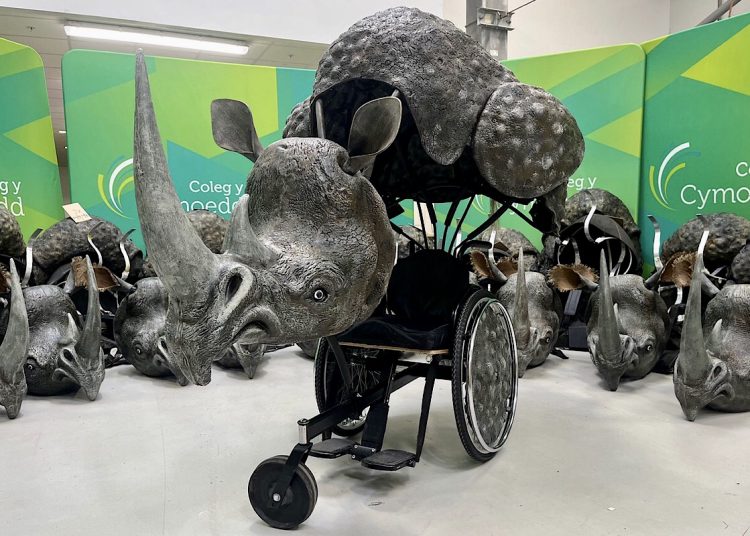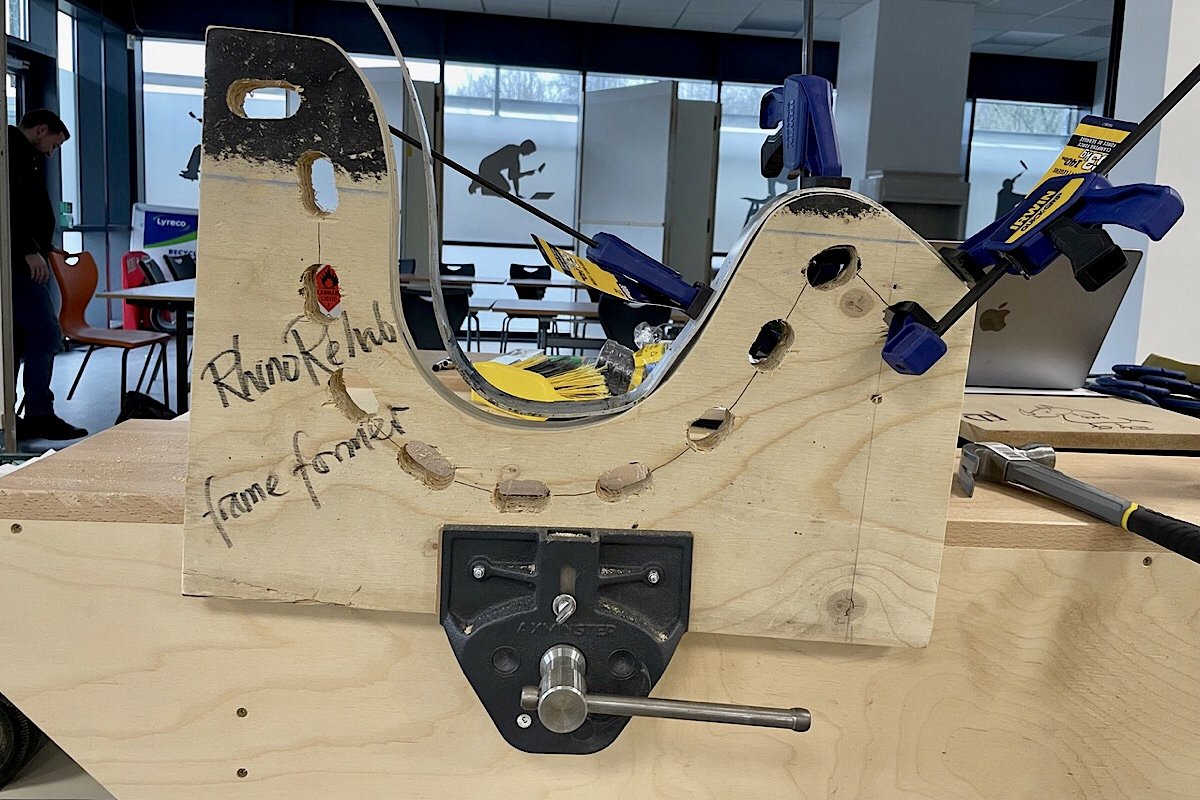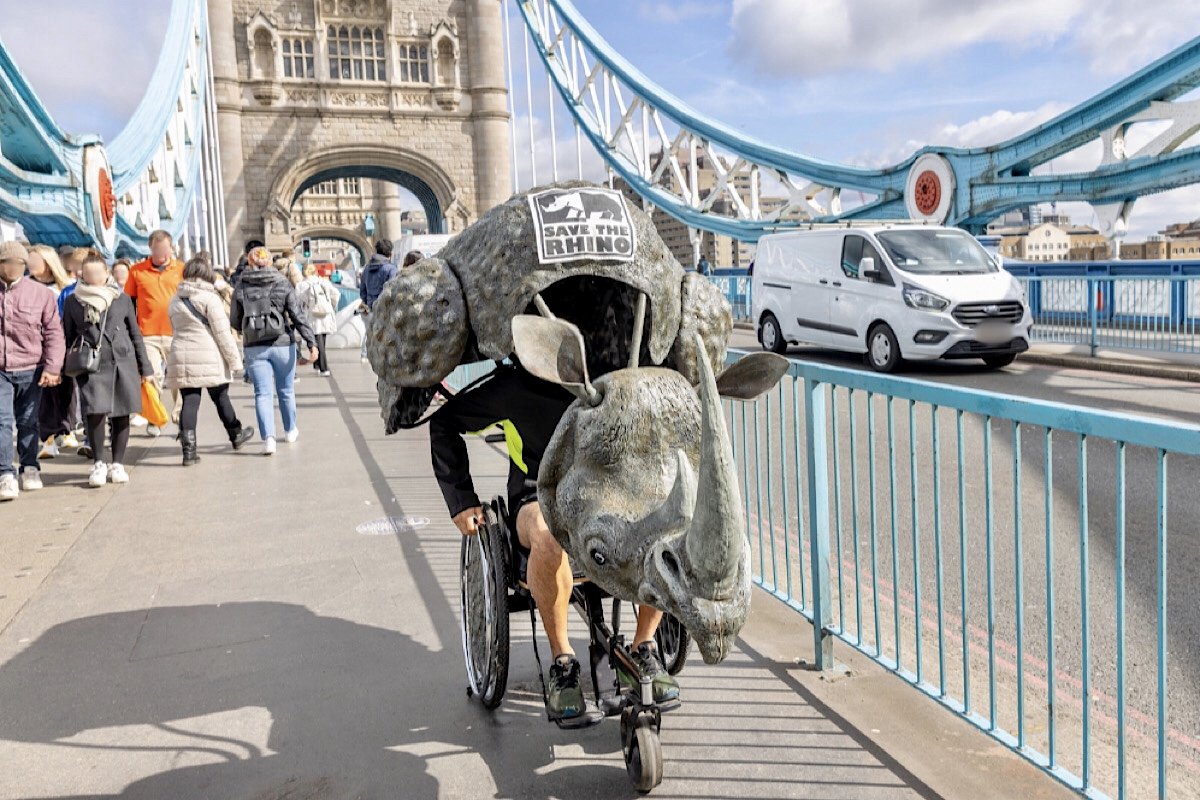Rhinos help the Hidden People of the Welsh Valleys: saving the rhino suit
Written by William Todd-Jones
Link to article in Bylines Cymru
A broken old rhino suit is perhaps symbolic. But rehabilitating rhino costumes has made magic for marginalised people … and marathon history

Running a marathon in a rhino suit is one way to help the environment, but not everyone can run a marathon. There are other ways … and the students and staff of Coleg y Cymoedd have helped in every way they possibly could.
From the outside, the costumes didn’t look too bad – they were mostly holding their iconic shape. But on closer inspection, it was clear that decades of use had taken its toll. Peeling back the layers was like going back in time. It revealed a history of Save the Rhino’s growth, from a small charity with a commitment to making a positive difference for these critically endangered animals, to the ‘go to’ mature and respected conservation organisation it is today.

Every year, when the London Marathon is aired on TV, my Grandmother and I make a game out of ‘spotting the rhino’ in the running crowd. It was incredibly exciting then to see costumes up close, deconstructed and in need of care.Raymond Munro
Layers of rhino suit history
Each rhino suit had been subjected to multiple patch-ups using thick layers of tape, wire, and anything else the repairer could lay their hands on, applied to restore temporary usefulness. For over 30 years, countless rhino costume wearers had stuck, lashed, and bodged, just enough to get through their challenge.
I even found the original 1989 layer, where each costume carried the name of a character from the opera Born Again, for which it had originally been intended. I’d been the creature movement specialist and stunt rhino on the production, so seeing those names brought back powerful memories.
Little did I imagine how far from the Chichester Festival these theatrical costumes would travel, or what impact they’d have in the world.

But now there’s another story to tell. It’s about giving agency to people who otherwise would not have an opportunity to help save the rhino, or anything else.
We worked alongside Todd and several other groups of learners to restore these 30-year-old costumes to glory. From the beginning, it was an extremely insightful look into the art of prop and costume making, and we learnt about multiple techniques in a hands-on way. This was really great and valuable, especially as someone with an interest in these art forms.Raymond Munro
Coleg y Cymoedd
The student population of Coleg y Cymoedd – College of the Valleys – is drawn from areas classed as having high levels of deprivation. There’s malnutrition and destitution in the Welsh Valleys, and Covid hit these people hard. Everyone there knows someone who died in the first wave.
In living memory, ‘The Valleys’ were one of the great industrial centres of a world-spanning empire. Their people had purpose and prospect, drive and opportunity. But that came to a crashing halt at the end of the 1970s, as state-owned industry was deliberately and doggedly dismantled.
Now once-great coal and steel towns are driven past at speed, on trunk roads that avoid the crumbling centres – centres sometimes beset by substance abuse and dysfunctional relationships. Four generations of families have been forced to rely on grudging handouts.

They’ve been classified as burdensome, an embarrassment, a people to be hidden. “How can we expect anything from them?”, some ask. But there’s the possibility of change. If the individual can be helped to develop a sense of dignity, born out of pride in what they do, they can themselves become the tools of their own salvation.
The main cohort of students worked with were Entry Level 3 Vocational Access Learners, who hadn’t been able to ascend in a system focusing on academic pathways. Many hadn’t participated in mainstream education in years. Many have been subject to desperate childhoods, and struggled with poor mental health. A large percentage could probably be classified as neurodivergent – had the term existed in the 1970s, it would’ve been applied to me.

The environment was thoroughly encouraging – it was my first time hearing about things like kimble tagging, but that never felt daunting. Things were explained to us carefully and properly. It was also lovely to work with someone as clearly passionate about their work (both in terms of puppetry and animal conservation), as it’s a thing that really bleeds into your own attitude towards the work.Raymond Munro
Getting down to the bone
The better term would be ‘learners’. And on this planet so damaged by human activity, we all need to learn.
Over the course of months, I learned. I learned that these young people who were rehabbing the rhinos were habilitating themselves.

With the help of blasting tunes, Donna’s Entry Level 3 Construction learners cleaned off the 1980s costume frames – scraping, slicing, snipping, scrubbing. Until, by week two, we’d got back to the original aluminium. And found the structure wrecked! This job was going to take much longer than expected.
It’s not easy being green: students at Coleg y Cymoedd pay tribute to Todd’s friend Jim ‘Kermit’ Henson
Frames
We set to reshaping. Hammering the curves back into shape, splicing the breaks, riveting the junctions. All so that the frame could again support the suit, carry the head and, most importantly, ensure the comfort of the wearer. Though ‘comfort’ might not be the right word for the rhino suit, marathon runners!
Bodies
Each rhino suit is a tailored cone of nylon sacking with panels of textured foam ’tagged’ to it, representing a rhino’s skin. Most of the tags needed replacing – thousands in total. This took complete focus, as the needles of the tag guns were very sharp. Lene’s Entry Level 3 Creative Arts and Media learners spent weeks tagging and glueing the bodies so they would be fit to last another 30 years.

Heads
The original heads gave great service, but their vacuum-formed plastic had become brittle. Nothing for it but to replace each one.
From flat sheet to mounted head takes about 40 hours. Alistair’s props students trim out, sand down, stick together, fill in, prime, paint, and position.

Legs
The costumes originally had legs, but in recent years those have been abandoned, making the suit much less rhino-like. I’m ambitious about restoring the look. So, with the guidance of lecturer Esme, the college’s fashion students sew up pachyderm-patterned pants.

During our time with the rhinos, we learnt so much about costume construction. But also about the rhinos that Save the Rhino International works so hard on helping. It felt good to know that I was contributing, even if in a small part, to this effort.Raymond Munro
The smallest offering

While we were helping sand the heads for the rhinos, I was also interviewed by a Media learner making a short film about the reconstruction of the rhino costume, where I mentioned all of this. Being a part of this film was also exciting.Raymond Munro
Also very deserving of mention:
- Engineering students engineered.
- Sports students road-tested.
- Media students documented.

It is a luxury to perform good works. You need to be in a position of personal security, and have sufficient wealth that you can gift, without the cost of that gift leaving you vulnerable. From people who have little, even the smallest offering is precious.

And the Rough Terrain rhino suit wheelchair will make history by becoming the first ever allowed to compete in the main event of the London Marathon, to raise awareness of rhino protection. It is a marvellous forward movement for conservation, sport, and disability equality alike.
Over 150 students from the College of the Valleys helped. By helping the rhinos, the students from the Hidden place were also helping themselves. By helping themselves, they will help the Valleys be visible again. And help others be more visible too.


